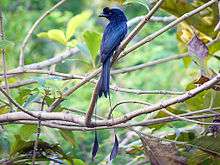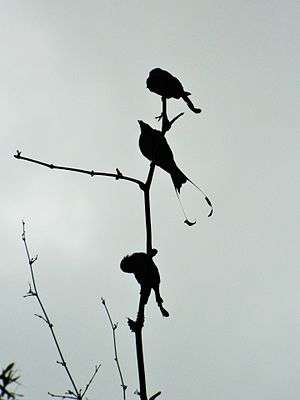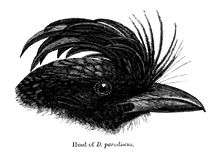Greater racket-tailed drongo
| Greater racket-tailed drongo | |
|---|---|
 | |
| Scientific classification | |
| Kingdom: | Animalia |
| Phylum: | Chordata |
| Class: | Aves |
| Order: | Passeriformes |
| Family: | Dicruridae |
| Genus: | Dicrurus |
| Species: | D. paradiseus |
| Binomial name | |
| Dicrurus paradiseus Linnaeus, 1766 | |
| Synonyms | |
|
Dissemurus paradiseus | |
The greater racket-tailed drongo (Dicrurus paradiseus) is a medium-sized Asian bird which is distinctive in having elongated outer tail feathers with webbing restricted to the tips. They are placed along with other drongos in the family Dicruridae. They are conspicuous in the forest habitats often perching in the open and by attracting attention with a wide range of loud calls that include perfect imitations of many other birds. It has been suggested that these imitations may help in the formation of mixed-species foraging flocks, a feature seen in forest bird communities where many insect feeders forage together. These drongos will sometimes steal insect prey caught or disturbed by other foragers in the flock. They are diurnal but are active well before dawn and late at dusk. Owing to their widespread distribution and distinctive regional variation, they have become iconic examples of speciation by isolation and genetic drift.[2]
Description

In most of its range in Asia, this is the largest of the drongo species and is readily identifiable by the distinctive tail rackets and the crest of curled feather that begin in front of the face above the beak and along the crown to varying extents according to the subspecies. The tail with twirled rackets is distinctive and in flight it can appear as if two large bees were chasing a black bird. In the eastern Himalayas the species can be confused with the lesser racket-tailed drongo, however the latter has flat rackets with the crest nearly absent.[3]
This widespread species includes populations that have distinct variations and several subspecies have been named. The nominate form is found in southern India, mainly in forested areas of the Western Ghats and the adjoining hill forests of peninsular India. The subspecies in Sri Lanka is ceylonicus and is similar to the nominate form but slightly smaller. The subspecies found along the Himalayas is grandis and is the largest and has long glossy neck hackles. The Andaman Islands form otiosus has shorter neck hackles and the crest is highly reduced while the Nicobars Island form nicobariensis has a longer frontal crest and with smaller neck hackles than otiosus.[3] The Sri Lanka drongo D. lophorinus used to be treated as a subspecies due to the suggestion that it formed hybrids with ceylonicus is considered a separate species in newer taxonomic treatments on the basis of their overlapping ranges.[3][4] Specimens of the nominate form have sometimes been confused with lophorinus.[5] Considerable variation in shape of the bill, extent of the crest, hackles and tail rackets exists in the island populations of Southeast Asia. The Bornean brachyphorus (=insularis), banguey of Banggai lack crests (banguey has frontal feathers that arch forwards) while very reduced crests are found in microlophus (=endomychus; Natunas, Anambas and Tiomans) and platurus (Sumatra). A number of forms are known along the Southeast Asian islands and mainland including formosus (Java), hypoballus (Thailand), rangoonensis (northern Burma, central Indian populations were earlier included in this) and johni (Hainan).[6]
Young birds are duller, and can lack a crest while moulting birds can lack the elongate tail streamers. The racket is formed by the inner web of the vane but appears to be on the outer web since the rachis has a twist just above the spatula.[7]

Distribution and habitat
The distribution range of this species extends from the western Himalayas to the eastern Himalayas and Mishmi Hills in the foothills below 4000 feet. They are found in the hills of peninsular India and the Western Ghats. Continuing into the west to the islands of Borneo and Java in the east through the mainland and islands.[8][9]
Behaviour and ecology

Like other drongos, these feed mainly on insects but also feed on fruits and visit flowering trees for nectar. Having short legs, they sit upright and are often perched on high and exposed branches. They are aggressive and will sometimes mob larger birds especially when nesting.[10] They are often active at dusk.[9]
Their calls are extremely varied and include monotonously repeated whistles, metallic and nasal sounds as well as more complex notes and imitations of other birds. They begin calling from as early as 4 am in moonlight often with a metallic tunk-tunk-tunk series.[11] They have an ability to accurately mimic alarm calls of other birds that are learnt through interactions in mixed-species flocks. This is quite unusual, as avian vocal mimicry has hitherto been believed to be ignorant of the original context of the imitated vocalization. African grey parrots are known to use imitated human speech in correct context, but do not show this behavior in nature.[12] This drongo's context-sensitive use of other species' alarm calls is thus analogous to a human learning useful short phrases and exclamations in a number of foreign languages. A special alarm note is raised in the presence of shikras that has been transcribed as a loud kwei-kwei-kwei...shee-cuckoo-sheecuckoo-sheecuckoo-why!.[11] They have been said to imitate raptor calls so as to alarm other birds and steal prey from them in the ensuing panic.[13][14] They are also known to imitate the calls of species (known sometimes even to fluff up and moving head and body like a jungle babbler) that typically are members of mixed-species flocks such as babblers[15] and it has been suggested that this has a role in the formation of mixed-species flocks.[16] In some places they have been found to be kleptoparasitic on others in mixed-species flock, particularly laughingthrushes but they are most often involved in mutualistic and commensal relations.[17][18][19] Several observers have found this drongo associating with foraging woodpeckers[20][21][22] and there is a report of one following a troop of macaques.[23]
The greater racket-tailed drongo is a resident breeder throughout its range. The breeding season in India is April to August. Their courtship display may involve hops and turns on branches with play behaviour involving dropping an object and picking it in mid air.[11] Their cup nest is built in the fork of a tree[3] and the usual clutch is three to four eggs. The eggs are creamy white with blotches of reddish brown which are more dense on the broad end.[10]
In culture
They common whistle note that is made leads to its local name in many parts of India of kothwal (which means a "policeman" or "guard", who used a whistle that produced a similar note), a name also applied to the black drongo and in other places as the Bhimraj or Bhringaraj.[24] Prior to the 1950s it was often kept in captivity by people in parts of India. It was said to be very hardy and like a crow, accommodating a varied diet.[25][26] Edward H. Schafer considered the greater racket-tailed drongo as the basis for the divine kalaviṅka birds mentioned in Chinese and Japanese Buddhist texts.[27]
References
- ↑ BirdLife International (2012). "Dicrurus paradiseus". IUCN Red List of Threatened Species. Version 2013.2. International Union for Conservation of Nature. Retrieved 26 November 2013.
- ↑ Mayr, E.; Vaurie, C. (1948). "Evolution in the Family Dicruridae (Birds)". Evolution. 2 (3): 238–265. doi:10.2307/2405383. JSTOR 2405383. PMID 18884665.
- 1 2 3 4 Rasmussen PC; JC Anderton (2005). Birds of South Asia: The Ripley Guide. Volume 2. Smithsonian Institution & Lynx Edicions. pp. 592–593.
- ↑ Saha, Bhabesh Chandra; Mukherjee, Ajit Kumar (1980). "Occurrence of Dicrurus paradiseus lophorhinus (Vieillot) in Goa (India)". J. Bombay Nat. Hist. Soc. 77 (3): 511–112.
- ↑ Ripley,S Dillon (1981). "Occurrence of Dicrurus paradiseus lophorhinus (Vieillot) in Goa (India) - a comment". J. Bombay Nat. Hist. Soc. 78 (1): 168–169.
- ↑ Vaurie, C (1949). "A revision of the bird family Dicruridae". Am. Mus. Nat. Hist. 93: 203–342. hdl:2246/1240.
- ↑ Ali, Salim (1929). "The racket-feathers of Dissemurus paradiseus". J. Bombay Nat. Hist. Soc. 33 (3): 709–710.
- ↑ Peters, JL (1962). Check-list of the birds of the world. Volume 15. Museum of Comparative Zoology. pp. 154–156.
- 1 2 Ali S; SD Ripley (1986). Handbook of the birds of India and Pakistan. 5 (2nd ed.). Oxford University Press. pp. 135–143.
- 1 2 Whistler, Hugh (1949). Popular handbook of Indian Birds. Fourth edition. Gurney and Jackson, London. pp. 160–161.
- 1 2 3 Neelakantan, KK (1972). "On the Southern Racket-tailed Drongo Dicrurus paradiseus paradiseus (Linn.)". J. Bombay Nat. Hist. Soc. 69 (1): 1–9.
- ↑ Goodale, E; Kotagama, SW (2006). "Context-dependent vocal mimicry in a passerine bird" (PDF). Proc. R. Soc. B. 273 (1588): 875–880. doi:10.1098/rspb.2005.3392. PMC 1560225
 . PMID 16618682.
. PMID 16618682. - ↑ Bourdillon, T. F. (1903). "The birds of Travancore". J. Bombay Nat. Hist. Soc. 15 (3): 455.
- ↑ S. Harsha K. Satischandra; Prasanna Kodituwakku; Sarath W. Kotagama; Eben Goodale (2010). "Assessing "false" alarm calls by a drongo (Dicrurus paradiseus) in mixed-species bird flocks". Behavioral Ecology. 21 (2): 396–403. doi:10.1093/beheco/arp203.
- ↑ Daniel,JC (1966). "Behaviour mimicry by the Large Racket-tailed Drongo [Drongo paradiseus (Linnaeus)]". J. Bombay Nat. Hist. Soc. 63 (2): 443.
- ↑ Goodale, E; S. Kotagama (2006). "Vocal mimicry by a passerine bird attracts other species involved in mixed-species flocks" (PDF). Animal Behaviour. 72 (2): 471–477. doi:10.1016/j.anbehav.2006.02.004.
- ↑ King, DI; JH Rappole (2001). "Kleptoparasitism of laughingthrushes Garrulax by Greater Racket-tailed Drongos Dicrurus paradiseus in Myanmar" (PDF). Forktail. 17: 121–122.
- ↑ Harsha, S; K Satischandra; EP Kudavidanage (2007). "The benefits of joining mixed-species flocks for Greater Racket-tailed Drongos Dicrurus paradiseus" (PDF). Forktail. 23: 145–148.
- ↑ Goodale, E.; Kotagama, S.W. (2008). "Response to conspecific and heterospecific alarm calls in mixed-species bird flocks of a Sri Lankan rainforest". Behavioral Ecology. 19 (4): 887–894. doi:10.1093/beheco/arn045.
- ↑ Bates, RSP (1952). "Possible association between the Large Yellownaped Woodpecker (Picus flavinucha) and the Large Racket-tailed Drongo (Dissemurus paradiseus)". J. Bombay Nat. Hist. Soc. 50 (4): 941–942.
- ↑ Styring, AR; Kalan Ickes (2001). "Interactions between the Greater Racket-tailed Drongo Dicrurus paradiseus and woodpeckers in a lowland Malaysian rainforest" (PDF). Forktail. 17: 119–120.
- ↑ Johnson,JM (1975). "The Racket Tailed Drongo - Dicrurus paradiseus behaviour of imitating the call of the Great Black Wood-pecker, Dryocopus javensis in Mudumalai Sanctuary". Indian Forester. 98 (7): 449–451.
- ↑ Ganesh,T (1992). "A silent association". J. Bombay Nat. Hist. Soc. 89 (3): 374.
Incorrectly notes species as remifer
- ↑ Anonymous (1998). "Vernacular Names of the Birds of the Indian Subcontinent" (PDF). Buceros. 3 (1): 53–109.
- ↑ Finn, Frank (1899). "On a new species of Bhimraj (Dissemurus), with some observations on the so-called family Dicruridae". Journal of the Asiatic Society of Bengal. 68 (2): 119–121.
- ↑ Finn, Frank (1904). The Birds of Calcutta. Thacker, Spink & Co, Calcutta. p. 32.
- ↑ Schafer, EH (1963). The golden peaches of Samarkand: a study of Tʻang exotics. University of California Press. pp. 103–104.
External links
| Wikimedia Commons has media related to Greater racket-tailed drongo. |
